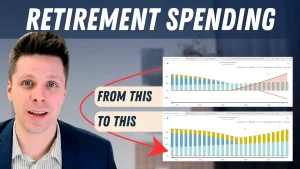Consider these two stocks.
Over the last five years, Stock “A” has seen its share price sputter with a negative return of 3.19%. Over that same period, its revenue growth ranks dead last compared to its competitors. Its historical valuation multiple also ranks last, which indicates that its competitors have a greater opportunity for growth. This makes sense based on how poorly this company has performed over the last five years.[1]
Stock “B” has been around for nearly 200 years and has seen its share price increase by over 300% in the last 20 years. Over the last five years, they have increased their revenues and dividend by over 25%. Their dividend is extremely consistent, and the last time it was reduced was in 2001. Even with their increased revenues, they are currently trading at 10.40% below their historical valuation multiple. This indicates that there is still room for this stock to grow.[2]
So which stock would you like to purchase today?
It seems like an easy answer.
What if I told you Stock “A” was Scotiabank and Stock “B” was also Scotiabank?
To quote Mark Twain, “There are lies, damned lies, and statistics.” Now, everything I told you was factual, but the way I used the statistics allowed me to control the narrative and bolster my argument.
The same thing occurs every day in the stock market. You have one analyst arguing that you should buy Stock X and you have another analyst arguing that you should be selling Stock X. They are likely both truthful, and each is using statistics to tell you the side of the story that they want you to see.
Investing Guidelines to live by
So before you go out and make a life-changing financial decision based on a stock tip from your brother-in-law, here are 50 investing guidelines that I like to follow.
- Have a goal with your portfolio
- Have a strategy to achieve that goal
- If you want a higher rate of return – take more risk
- If you can’t handle the ups and downs – take less risk
- If you’re comparing two investments, each will likely look better than the other based on the start date you choose
- If you’re comparing two investments that have the same strategy, buy the cheaper one
- If you need access to money in a short period of time, it shouldn’t be invested in the stock market
- If you’re buying a stock, someone else is selling it to you. What do they know that you don’t?
- If you’re selling a stock, someone else is buying it from you. What do they know that you don’t?
- The best thing you can do to increase the value of your portfolio is to save more money
- Don’t dabble with what you can’t afford to lose
- Everyone talks about their winners; you’ll rarely hear about their losers
- Don’t let your neighbor’s success dictate your investment decisions – A flashy lifestyle usually equates to debt
- Be wary of an advisor selling you on their investment performance – they can make the numbers show you anything
- Reading one article doesn’t make you an expert
- There’s no such thing as a no-brainer investment
- If you invest in passive investments, you will slightly underperform the market
- If you invest in active investments, you will likely underperform passive investments
- To time the market perfectly you have to be right twice – when you buy and when you sell – good luck with that
- Your asset allocation (what you have in stocks, bonds, cash…) will dictate the majority of your return
- A strategy that worked last year doesn’t necessarily mean it will work again this year
- From Jan 1, 1969 – Oct 12, 2018, the TSX has had a positive return 66% of the time over a one year period
- From Jan 1, 1969 – Oct 12, 2018, the TSX has had a positive return 79% of the time over a five year period
- From Jan 1, 1969 – Oct 12, 2018, the TSX has had a positive return 100% of the time over a ten year period
- If you’re investing, make sure you have a long timeframe
- Don’t worry about the day-to-day performance of the stock market – You wouldn’t measure your drive from Winnipeg to Brandon with a ruler, nor should you measure your portfolio on a daily basis; the measuring stick is much too short
- The Dow Jones Industrial Average dropped 22.61% in a single day on Oct 19, 1987, which is now known as Black Monday[3]
- Had you invested in the Dow Jones Industrial Average the trading day before Black Monday, which would have been terrible market timing, you’d be up 1,110% today – try to find someone who isn’t happy with that return
- If you have a long timeframe, stop waiting for the next market correction to invest – it doesn’t matter (see #28)
- Let compounding be your best friend
- Don’t ever leave yourself overly exposed to one portion of the market
- Having a properly diversified portfolio means you’ll always be upset that a piece of it is underperforming the rest
- Having a lot of positions in your portfolio doesn’t make you more sophisticated
- Having a lot of positions in your portfolio makes things more complicated
- Bubbles happen because people can’t stand it when others who are “dumber” than they are get rich
- If you’ve blown a bubble before, you know it can eventually pop
- Losing money feels worse than making money
- Keep your emotions out of it
- There are no if’s or but’s – there’s just reality
- Don’t be a hero, stick to your plan
- If you’re going to double down on an investment, don’t let it be because you’re stubborn
- If someone asks you what’s going to happen in the market, your answer should be “I don’t know”
- Infinite factors are affecting the market, and you likely control none of them – If it were that easy to predict, we would all be billionaires
- Investing is like golfing – It’s not about how many good shots you hit, it’s about how many bad shots you can avoid
- Don’t worry about making short-term market moves – Would you sell your car at a ridiculously low price for a bicycle the next time you’re on route to Brandon and stuck in traffic on Portage Avenue? Don’t lose sight of your long-term journey.
- Be wary of financial talking heads – They are selling elevators with “plunge and soar” as options rather than “up and down”
- Just as it doesn’t matter how good a farmer you are; if it rains on your crop, there won’t be much to harvest. So too does it not matter how good an investor you are; if the President send out a negative Tweet, everyone’s portfolio is going down.
- If you want to rip up your investment statement, it’s probably a good time to buy low
- If you want to frame your investment statement, it’s probably a good time to diversify your portfolio
- Have realistic expectations
[1] All data accurate as of writing on July 25th, 2019
[2] All data accurate as of writing on July 25th, 2019
[3] https://money.cnn.com/2017/10/19/investing/romans-numeral-black-monday/index.html






